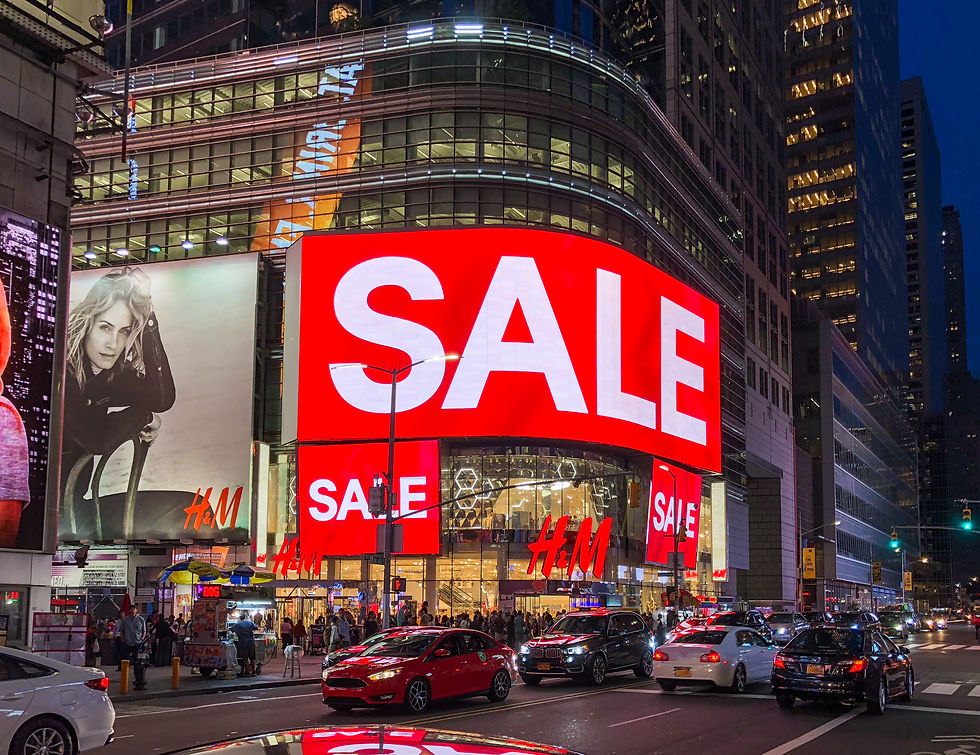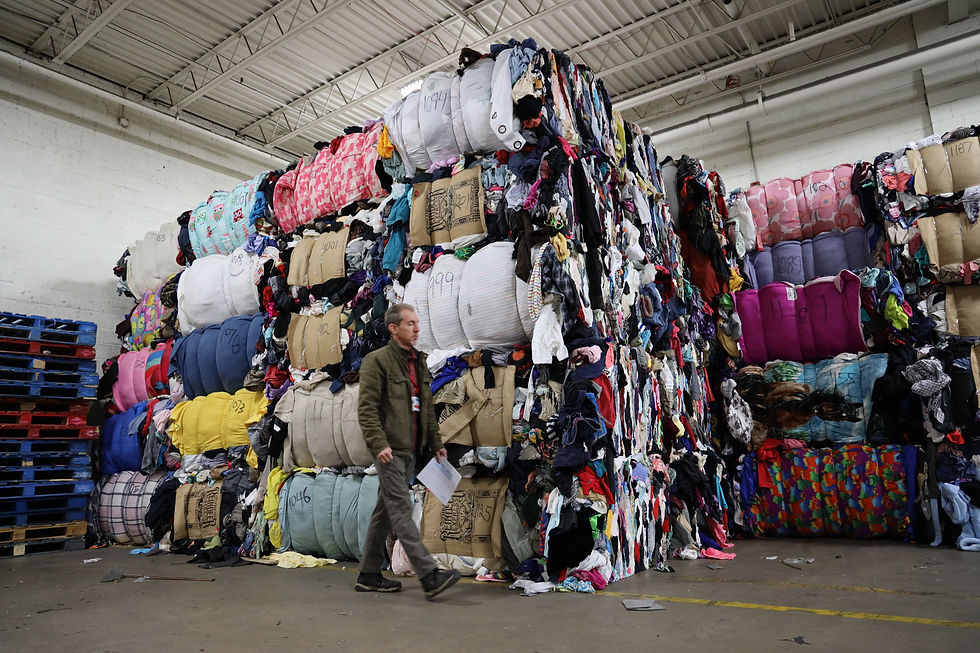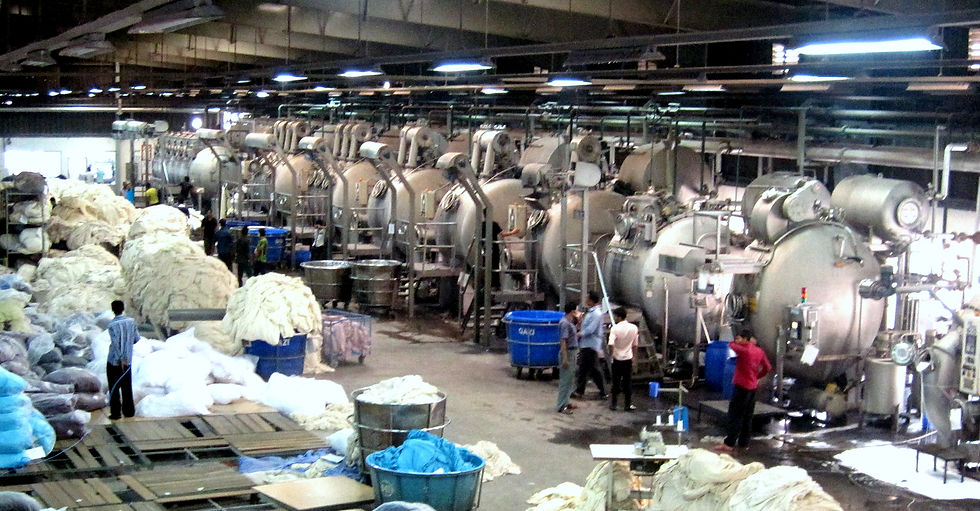Blood on Our Hands: The Price of Fast Fashion
- Human Rights
- Dec 15, 2021
- 8 min read
Our constant demand for new, trendy clothing is fueling environmental destruction on an unprecedented scale and propping up an industry built on slave labor and genocide.
Amelia Lake | amelia.lake@yale.edu

Thanks in part to videos like these, SHEIN has become one of the most-mentioned brands on social media, catapulting the company to yearly sales of over $10 billion. SHEIN’s wild success has been bolstered by its dirt-cheap prices (a skilled shopper could hypothetically assemble an entire outfit for less than $30) and its vast assortment of styles—about 1,000 new pieces are added each day. While this trend has become a quick favorite for many budget-conscious Gen Z shoppers, it reflects a disturbing and damaging shift in how we view and consume clothing.

(“SALE at H&M Store, Broadway, Times Square - NYC”. Image courtesy of Will Buckner. Licensed under CC BY-SA 4.0)
“Fast fashion” refers to a business model in which high-end fashion designs are rapidly copied and mass-produced, then sold at a low cost. Brands using fast fashion production methods typically launch new styles every week and stock limited quantities of each garment to incentivize shoppers to pounce on new arrivals before they’re gone. The ability of behemoths like H&M, Zara, and Forever21 to keep their shelves constantly stocked with new products relies on the availability of cheap synthetic materials (such as polyester, nylon, and acrylic), efficient supply chains, and sweatshop labor, which together can see trends go from the catwalk to clothes hangers in as little as 15 days. The market for fast fashion is highly profitable and only growing; valued at $25.09 billion in 2020, it is expected to soar to a whopping $39.84 billion in 2025.
The toll on our planet
By some estimates, the fashion industry is responsible for 10% of yearly carbon emissions, more than international flights and maritime shipping combined. The UN predicts that textile-related carbon emissions will increase by as much as 60% by 2030. The dyeing process alone consumes dizzying amounts of water—about 21 trillion gallons annually. Runoff from production facilities, often contaminated with carcinogenic chemicals, dyes, and heavy metals, pollutes local waterways, killing aquatic plants and animals. For many impoverished communities in developing nations, this chemical-laden sludge is the only available water for drinking and crop irrigation. Garments are often poorly-constructed and made from petroleum-based textiles, which do not biodegrade, and shed plastic microfibers whenever they are worn and washed. Microfiber pollution contaminates water supplies and marine life, and even makes its way into our bodies. The full extent of the health effects of microplastic consumption are yet unknown, but research has suggested links to metabolic disturbances, neurotoxicity, and cancer.
In order to remain profitable at low prices, fast fashion encourages and depends on a culture of consumerism in which clothing trends rapidly become outdated, pressuring consumers to constantly buy new things. Where fashion labels previously had 4 seasons per year, the trend has now shifted towards 52 yearly “micro-seasons”. Consequently, the longevity of our clothing has shrunk. Compared to 15 years ago, the average consumer buys 60% more clothing per year and wears each garment only half as long. In response to increased scrutiny of their environmental impact, many fast fashion brands have turned to “greenwashing”, a deceptive form of marketing in which consumers are led to believe that a company’s products are environmentally friendly or sustainable. H&M’s Conscious Collection campaign, for example, encourages shoppers to bring their used, unwanted clothes to in-store recycling bins in return for discounts on future purchases. However, less than one percent of collected clothing will actually be recycled; critically, the campaign also incentivizes customers to continue consuming.

(“1R1A2469”. Image courtesy of MPCA Photos. Licensed under CC BY-NC 2.0)
Donating old and unwanted clothes, similarly, may be doing more harm than good. Charities and thrift storesre increasingly “overrun” with more product than they can handle. The technology simply does not exist yet to recycle these fabrics on a scale large enough to keep up with the supply, and governments around the world are struggling to cope with the influx of textile waste. More often than not, discarded and donated garments are sent to developing nations and re-sold, undercutting local textile industries. Garments that cannot be sold are dumped in landfills and burned.
The human cost of our clothes
To keep manufacturing costs low, clothing production is outsourced to nations with weak or unenforced workers’ rights legislation. Garment workers suffer low pay, wage theft, and unsafe working conditions. Workers who raise complaints are threatened with replacement. This systemic entrenchment of apathy and callous disregard for the wellbeing of workers has resulted in disasters such as the 2014 Dhaka garment factory collapse in Bangladesh, in which over a thousand workers were killed after the building owners had ignored warnings of potential structural failure.

(“Knit fabric production in a RMG factory of Bangladesh”. Image courtesy of Fahad Faisal via Wikimedia Commons. Licensed under CC BY-SA 4.0)
Despite massive outcry in wake of the disaster, little has changed. Far from being an exception to the norm, these disturbing labor practices are endemic to the fast fashion industry and are hardly limited to the borders of Bangladesh.
The Uyghurs, a majority-Muslim ethnic minority indigenous to northwest China, have faced political and cultural repression since their homeland’s incorporation into the People’s Republic of China as the Xinjiang Uyghur Autonomous Region (XUAR). In 2014, in response to increasing ethnic tension and separatist violence, the Chinese government launched the Strike Hard Campaign Against Violent Terrorism, a “people’s war against terror” initially consisting of measures targeting the Internet communications and religious materials of Uyghurs. Today, an estimated 1.8 million people, mostly Uyghurs but also consisting of Kazakhs, Kyrgyz, and other Turkic peoples, are believed to be imprisoned in state-run internment camps (officially referred to by the Chinese government as “vocational education and training centers”), making it the largest-scale arbitrary detention of ethnic and religious minorities since World War II. Testimonies from prisoners speak of torture, including waterboarding, electric shocks, sexual violence, and forced sterilization. As part of a “deradicalization” campaign intended to strip Muslims of their religious and cultural identities, prisoners are subject to re-education and forced labor. The atrocities are directly linked to the textile industry—more than 80% of China’s cotton is sourced from the XUAR, and in turn, China supplies roughly 22% of the world’s cotton. A report released by the Coalition to End Uyghur Forced Labour says that it is “virtually certain” that almost every major apparel brand and retailer selling cotton products is implicated in Uyghur slave labor.
“I didn’t want to believe it was happening at first,” says Jewher Ilham. “But now it has gone far beyond intellectuals and political dissidents being targeted. Now it can be anyone—they don’t have to express any opinions or be involved in any political activity. They just need to be Uyghur.”
Jewher is an author and human rights advocate, the daughter of Uyghur scholar and economist Ilham Tohti, renowned for his work on Han-Uyghur relations, who is currently serving a life sentence in China on alleged charges of separatist activity. Jewher has not seen her father for over eight years, since he was detained at Beijing International Airport. She has not heard a word of her father since 2017, and her family are unable to visit him in prison.
“A lot of people claim that this is Western propaganda,” she says. “But no matter what people think, horrible things are happening in the Uyghur region. My family is suffering. Not just my father. My cousin is in prison, my uncles were sent to re-education camps—they are all living proof of what the Chinese government is doing to the Uyghurs. Hundreds of Uyghurs in the diaspora can testify to that.”
In spite of everything, Jewher believes that the plight of enslaved Uyghurs has not fallen on entirely deaf ears. “There have been positive actions, which I am pleased to see. Momentum has been building for years.” In January, US Customs and Border Protection issued a withhold and release order on cotton and tomato products from the Uyghur region. And on September 15, the EU announced its intent to propose a ban on products made with forced labor. “But it’s not enough,” she says, “because people are still suffering…and still being forced through those so-called ‘vocational training schools’ against their will.”
International collaboration, Jewher believes, is the key here. “China might not be afraid of US sanctions, or Germany or France or Australia individually, but how about if 20 or 30 countries are united on this front? Then they’ll have to rethink their policies. If there is no demand for forced labor, then there will be no forced labor.”
“But,” Jewher says, “There is only so much governments can do. I blame the corporations, really. This news isn’t new anymore. Corporations know what is happening, and look how few have done the right thing so far. Some choose to prioritize profits over human rights. Some are even proud of it.” Indeed, Hugo Boss and Asics are among the companies who have announced their intent to continue purchasing XUAR-sourced cotton.
The Coalition to End Uyghur Forced Labour, the organization Jewher works for, compiles lists of companies that have pledged, both publicly and privately, to withdraw their supply chains from the XUAR. So far, the call to action has received over 400 endorsements from over 40 countries around the world. The list of brands working with the Coalition to exit the XUAR in every level of their supply chain includes ASOS, Reformation, Marks and Spencer, and Eileen Fisher. Jewher urges student groups, universities, and brands to endorse the call to action, and to also vote with their wallets.
“Consumers can simply stop purchasing from brands that are valuing profits over human rights and start rewarding brands that have been doing the right thing. We need to let them know we do not want to spend money on items tainted by forced labor…Don’t underestimate your school’s power. Universities have ties with brands, especially sports brands. You’ll see all the college apparel in your bookstore—UnderArmour, Champion, and so on. There’s a huge amount of profits to be made from university apparel, and it’s stable income too. Brands don’t want to lose those licensees.”
While boycotts can heft a real clout against companies exploiting forced labor, they are more effectively implemented when paired with legislation. An updated version of the Uyghur Forced Labor Prevention Act was introduced in February. This bill would create a “rebuttable presumption” that any goods manufactured in XUAR are products of forced labor, prohibiting their import into the country unless evidence to the contrary is provided. It would also authorize the President to apply sanctions on anyone responsible for the trafficking of Uyghurs. Readers are encouraged to contact their U.S. Representatives and demand support for and sponsorship of the bill.
Our increasingly consumerist lifestyles have become the lifeblood of an ugly, destructive industry that our planet cannot withstand and that we cannot morally support. At the end of the day, while buying sustainably and ethically is a step up from indulging in fast fashion, the most environmentally-friendly clothes are always the ones you already own.
Rarely do we stop to contemplate the real cost of our clothing—how many gallons of water, how many microplastic fibers, how many polluted rivers, how many landfills. How many of us have ever bought a new garment and thought of the person who made it? Were they fairly compensated for their labor? Did they enjoy safe working conditions? Were they uneducated, or underprivileged, or trafficked? I hope, if anything, that having read this article might encourage you to consider these questions.
I’d like to express my deep gratitude to Jewher Ilham for sharing her time and words with me. I strongly encourage readers to visit her Twitter to read up on Jewher’s story and work, and if possible, make a donation to the fundraising page for her documentary Static & Noise, a film dedicated to the Uyghurs’ struggle for freedom in China.
Lastly, and especially in light of the upcoming holiday season, I challenge readers to critically examine their shopping habits and the companies they support—to ask themselves, the next time they are faced with the prospect of buying something new, “Do I really need this?”. While not everyone is in the financial position to ditch fast fashion altogether and invest only in ethically-sourced high-quality wardrobe pieces, for those of us who are capable, it is an important step to take. Individuals might not bear the sole responsibility for large-scale, systemic issues, but unlike so many other instances of horrendous human rights abuses, this is one instance in which our personal decisions can make an impact.
%20(1).png)








Comments